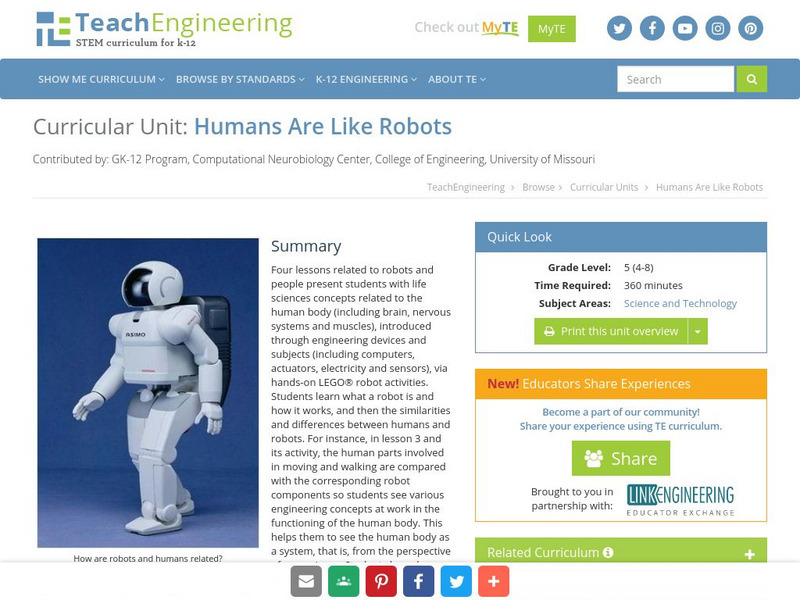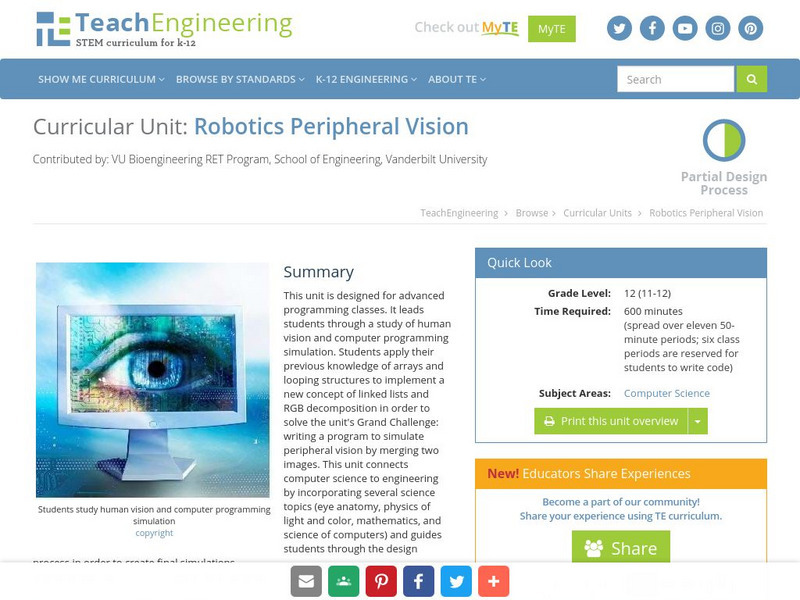Hi, what do you want to do?
Curated OER
Domestic Robots
Students examine the role of robots and science in our everyday lives. They discuss films with robots in them, read an online article and answer discussion questions, and in small groups design and illustrate a robot.
Tutorials Point
Artificial Intelligence
You needn't take a stress pill or don a space helmet to take a tutorial in artificial intelligence. In fact, HAL might recommend the course with great enthusiasm and confidence for those seeking an introduction to AI.
Curated OER
Curriculum Links To Numeracy
Youngsters practice looking for the links to numeracy in their classes. This isn't a worksheet but a curriculum guide for an entire unit. Teachers can use any part of the resource to extend or inform their teaching practices related to...
NASA
Marsbound! Mission to the Red Planet
It's time to go to Mars. Using the provided cards and mat, groups design a mission to Mars. The cards contain information about the different components of the launch and warn about a few mishaps that might occur along the way.
TeachEngineering
Teach Engineering: Humans Are Like Robots
Four lessons related to robots and people present students with life sciences concepts related to the human body (including brain, nervous systems and muscles), introduced through engineering devices and subjects (including computers,...
Read Works
Read Works: Passages: Paired Text: "World's Greatest Robot" by w.m. Akers
[Free Registration/Login Required] The paired passages "Streetcar!" and "World's Greatest Robot" explore the nature of sibling relationships. Question sets are provided for each passage separately and combined.
TeachEngineering
Teach Engineering: Robotics Peripheral Vision
This unit is designed for advanced programming classes. It leads students through a study of human vision and computer programming simulation. Students apply their previous knowledge of arrays and looping structures to implement a new...
TED Talks
Ted: Ted Ed: Make Robots Smarter
There are three major rules that we want our robots to follow: do not harm a human, obey us, and protect us. The prerequisite for these rules? We need to make robots smarter. Ayanna Howard explains how robots can become smarter (hint: it...
TED Talks
Ted: Ted Ed: Mysteries of Vernacular: Robot
In 1920, Czech writer Karel Capek wrote a play about human-like machines, thereby inventing the term robot from the Central European word for forced labor. Jessica Oreck and Rachael Teel explain how the science fiction staple earned its...
CommonLit
Common Lit: A Slick Little Robot
CommonLit.org is a wonderful resource to use in a Language Arts classroom. Each story or article is accompanied by guided reading questions, assessment questions, and discussion questions. In addition, students can click on words to see...
TED Talks
Ted: Ted Ed: Can Robots Be Creative?
People have been grappling with the question of artificial creativity- alongside the question of artificial intelligence- for over 170 years. For instance, could we program machines to create high quality original music? And if we do, is...
TED Talks
Ted: Ted Ed: Making a Car for Blind Drivers
Using robotics, laser rangefinders, GPS and smart feedback tools, Dennis Hong is building a car for drivers who are blind. It's not a "self-driving" car, he's careful to note, but a car in which a non-sighted driver can determine speed,...
Ingles Mundial
Ingles Mundial: Robots (Reading Comprehension Exercise)
A reading comprehension exercise designed for Spanish-speaking ELLs about the present and future use of robots. Instructions are in Spanish; exercise is in English.
TeachEngineering
Teach Engineering: Mission to Mars
The Mission to Mars curricular unit introduces students to Mars-the Red Planet. Students discover why scientists are so interested in studying this mysterious planet. Many interesting facts about Mars are revealed, and the history of...
PBS
Pbs Learning Media: Makers: Collection
The Maker Party, an initiative in which people around the world meet up, learn to make things, and share what they've made online. This collection is designed to support the Maker Party by providing a one-stop shop of STEM and digital...
TeachEngineering
Teach Engineering: Next Generation Surgical Tools in the Body
Through this unit, students act as engineers who are given the challenge to design laparoscopic surgical tools. After learning about human anatomy and physiology of the abdominopelvic cavity, especially as it applies to laparoscopic...
Khan Academy
Khan Academy: Start Here! Counting
This lesson focuses on the math needed to solve problems counting. In the first lesson you learned that it was possible to build 1000 possible robots using only a handful of parts. Now suppose the director only asks for a cast of 6...




















